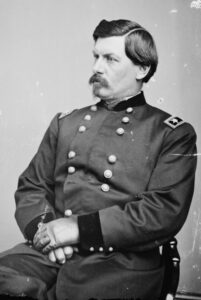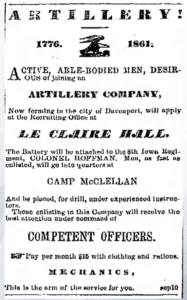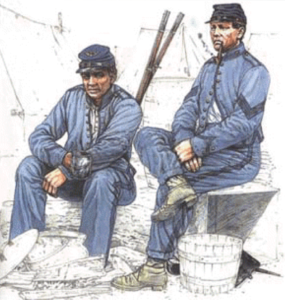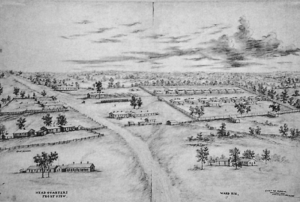
General George B. McClellan. National Portrait Gallery, Smithsonian Institution
After the start of the Civil War in 1861, Camp McClellan, named for Gen. George B. McClellan, was established here to train Union soldiers. Iowa, which was a newly formed state at the time, responded immediately at the beginning of the war and formed the First Iowa Infantry.
Just a few months after the attack at Fort Sumter, Iowa Adjutant General Nathaniel B. Baker moved his offices to Davenport. There, he established Camp McClellan on more than 300 acres of land owned by Thomas Russell Allen of St. Louis, MO. The camp encompassed the land from the Mississippi riverbank up to the ridge of the hills to what is now Crestwood Avenue. General McClellan himself did not reside at the camp, but it was named for him during the height of his popularity early in the war.
This site within Lindsay Park was chosen because this area (also one of Channel Cat’s ports) had the deepest water port, and at the time, the land formed a natural harbor named Stubbs Eddy. This offered an advantage to the number of boats it took to transport Union Soldiers to the frontlines of the war.
Camp McClellan became a major staging area for Iowa’s Union soldiers going to battle. Though it was designed to house over 1,300 men and 130 horses, initial buildings were deemed insufficient during the winter.

Advertisement in the Davenport Democrat, October 5th, 1861. Courtesy of RIA Museum
Over the course of the Civil War, more than 40,000 troops trained at Camp McClellan and then traveled south by steamboat. Throughout the Civil War, Iowa as a whole contributed over 72,000 men out of a population of around 675,000.

Soldiers in training took shifts to guard the prisoners until the Veterans Reserve Corps (VRC) replaced them. Courtesy of RIA Museum.
By the end of April 1862, the number of outgoing troops had diminished, and there was talk about turning the camp into an Army hospital. Troops continued to train there and some areas were changed into hospital quarters, which were cleaned and stocked by the people who worked with Annie Wittenmyer.
A few months after the Civil War ended in April of 1865, Camp McClellan’s headquarters burned down. By October, the hospital was closed. In early 1866, the remaining buildings were torn down and the land was returned to the Allen family.

Concept drawing for Camp McClellan. Courtesy of RIA Museum.

